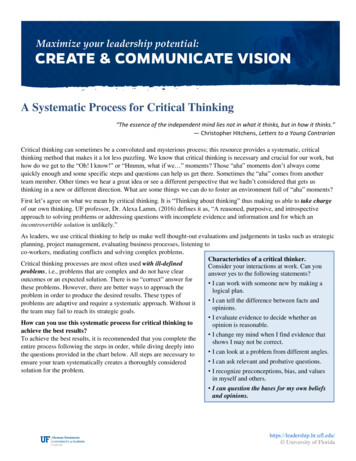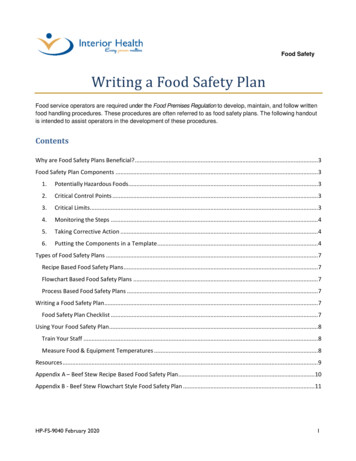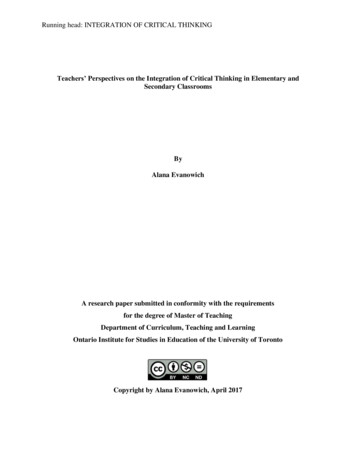
Transcription
A Systematic Process for Critical Thinking“The essence of the independent mind lies not in what it thinks, but in how it thinks.”― Christopher Hitchens, Letters to a Young ContrarianCritical thinking can sometimes be a convoluted and mysterious process; this resource provides a systematic, criticalthinking method that makes it a lot less puzzling. We know that critical thinking is necessary and crucial for our work, buthow do we get to the “Oh! I know!” or “Hmmm, what if we ” moments? Those “aha” moments don’t always comequickly enough and some specific steps and questions can help us get there. Sometimes the “aha” comes from anotherteam member. Other times we hear a great idea or see a different perspective that we hadn’t considered that gets usthinking in a new or different direction. What are some things we can do to foster an environment full of “aha” moments?First let’s agree on what we mean by critical thinking. It is “Thinking about thinking” thus making us able to take chargeof our own thinking. UF professor, Dr. Alexa Lamm, (2016) defines it as, “A reasoned, purposive, and introspectiveapproach to solving problems or addressing questions with incomplete evidence and information and for which anincontrovertible solution is unlikely.”As leaders, we use critical thinking to help us make well thought-out evaluations and judgements in tasks such as strategicplanning, project management, evaluating business processes, listening toco-workers, mediating conflicts and solving complex problems.Characteristics of a critical thinker.Critical thinking processes are most often used with ill-definedConsider your interactions at work. Can youproblems, i.e., problems that are complex and do not have clearanswer yes to the following statements?outcomes or an expected solution. There is no “correct” answer for I can work with someone new by making athese problems. However, there are better ways to approach thelogical plan.problem in order to produce the desired results. These types of I can tell the difference between facts andproblems are adaptive and require a systematic approach. Without itopinions.the team may fail to reach its strategic goals. I evaluate evidence to decide whether anHow can you use this systematic process for critical thinking toopinion is reasonable.achieve the best results? I change my mind when I find evidence thatTo achieve the best results, it is recommended that you complete theshows I may not be correct.entire process following the steps in order, while diving deeply into I can look at a problem from different angles.the questions provided in the chart below. All steps are necessary to I can ask relevant and probative questions.ensure your team systematically creates a thoroughly consideredsolution for the problem. I recognize preconceptions, bias, and valuesin myself and others. I can question the bases for my own beliefsand opinions.https://leadership.hr.ufl.edu/ University of Florida
A Systematic Process for Problem Solving which Requires Critical Thinkinghttps://leadership.hr.ufl.edu/ University of Florida
Roles for Problem Solving or Decision Making MeetingsIt can be helpful to use roles during the process and highly recommended to set a time limit for each section. Consider thefollowing roles to facilitate the best possible outcome during the critical thinking process.1. Team Leader or Presenter: Presents the facts of the challenge, problem or situation to the team. Listens to theteam’s brainstorming.2. Facilitator: Main responsibility is to ask the process questions of the presenter and the group, manage the timeboundaries and keep the team leader/presenter from controlling the conversation.3. Timekeeper: Monitors time and informs the facilitator and the group of the elapsed time allotments. Helps keeppeople focused and on task.4. Note-taker: Responsible for capturing a record of the group’s discussion for the case presenter, thus freeing-upthe team leader/presenter to listen and attend to the group’s conversation.PROBLEMPRESENTATION – The team leader or presenter will describe thefacts of the challenge, problem or situation to the team as well asany solutions that have previously been tried.Suggested Timing: 5 min1. INTERPRETATIONINTERPRETATION – To clarify the problem or situation andensure that all team members have a common understanding of theissue. Consider the 5W’s: who, what, when, why, where and how What’s happening? Who are the people involved? Who has ownership or a high stake in the process? What is the best way to characterize, categorize, or classifythis?Suggested Timing: 10 minANALYSIS – To discuss the problem thoroughly, exploring theintended and actual inferential relationships among the statementsand questions from the team members. Consider each person’sperspective, beliefs, assumptions and opinions. Analyze the factsand any metrics available to corroborate the evidence. Tell us your reasons for making that claim. What is your conclusion? What are you claiming? Why do you think that? What are the arguments (pros and cons)? What assumptions must we make to accept that conclusion? What is your basis for saying that? What are the underlying or hidden issues? What would success look like to all of the people involvedin the problem? What has the team leader/presenter contributed to theproblem?Suggested Timing: 20 min2. ANALYSISProblem Solving or Decision Making Meeting Agenda TemplateIt is helpful to provide a writtendescription of the problem prior to thesession.Team members ask questions to clarifythe problem.Once the team members feel that theyunderstand the problem deeply, they areready to move on to ANALYSIS.Team members discuss the problem,explore each person’s judgements,arguments, opinions, and conclusions.The team leader listens to thediscussion.Once the team members feels they haveexplored the questions, they are ready tomove on to INFERENCE.https://leadership.hr.ufl.edu/ University of Florida
3. INFERENCE4. EVALUATION5. EXPLANATIONINFERENCE – To identify and secure elements needed to drawreasonable conclusions. The team will use the data, statements,principles, evidence, beliefs, and opinions from the analysis phaseand brainstorm ideas. This is a time to identify possible solutionsand discuss the viability of each solution. Given what we know so far, what conclusions can we draw? Given what we know so far, what can we rule out? What does this evidence imply? If we abandoned or accepted that assumption, how wouldthings change? What additional information do we need to resolve thisquestion? If we believe these things, what would they imply for usgoing forward? What are the consequences of doing things that way? What are some alternatives we haven’t yet explored? Let’s consider each option and see where it takes us. Are there any undesirable consequences that we can andshould foresee?Suggested Timing: 20 minEVALUATION – To assess the credibility of the solutions from theinference phase and review any new evidence and ideas generatedsince the prior session. Evaluate with fresh eyes the validity of thepossible solutions and probe for weaknesses in thinking and logic. How credible is the claim? Why do we think we can trust what this person claims? How strong are those arguments? Do we have our facts right? How confident can we be in our conclusion, given what wenow know? What are the consequences of this solution? What would it look like in a year if we implemented thissolution?Suggested Timing: 10 minEXPLANATION – To describe the process the team went throughto arrive at the solutions. Clarifying the thinking process providescontext for how the thought process evolved. What were the specific findings or results of theinvestigation? Describe how you conducted that analysis. How did you come to that interpretation? Take us through your reasoning one more time. Why do you think that was the right answer or the solution? How would you explain why this particular decision wasmade? What is the context in which you made this decision?Suggested Timing: 10 minTeam members brainstorm possiblesolutions using all the informationavailable. The team leader can provideinput and direction, if desired.Once the team members feels they haveexplored all the information, data andquestions, a break is recommended.When the team reconvenes, they are readyto move on to EVALUATION, startingwith a recap of the process and possiblesolutions.Start by recapping the process, possiblesolutions and how the team arrived atthem.Team leader asks questions about thepossible solution. Then team membersevaluate the validity of their argumentor solution.Once the team members feel they havethoroughly evaluated their argument orsolution, they are ready to prepare theirEXPLANATION and consider actionsteps.Team members verbalize and outlinetheir explanation of their proposeddecision or solution.Once the team members have consensuson the proposed decision or solution, theypresent to the leader.https://leadership.hr.ufl.edu/ University of Florida
6. SELF-REGULATIONEXECUTIONSELF-REGULATION – To consciously check your thinking andevaluate your potential biases. Evaluate the team’s inferentialjudgments with a view toward questioning, confirming, validating,or connecting either one’s reasoning or one’s results. Our position on this issue is still too vague. Can we be moreprecise? How good was our methodology, and how well did wefollow it? Is there a way we reconcile these two apparently conflictingconclusions? How good is our evidence? OK, before we commit, what are we missing? I’m finding some of our definitions a little confusing. Canwe revisit what we mean by certain things before makingany final decisions?Suggested Timing: 10 minACTION STEPS – The team leader or facilitator outlines specificaction steps and assigns a team member to each task with expecteddeadlines.Suggested Timing: 15 minFinally the team leader closes the process by asking for the team’sinput on the process. What worked well and what can be improvedfor future problem solving sessions.Team leader questions, confirms,validates and connects the proposeddecisions or solutions to ensure acomplete process and conclusion.Once the team has reflected and feelsconfident in the solution, prepare to createspecific action steps.It is helpful to put the action steps into ashared excel sheet so all team memberscan monitor the implementation.SummaryUsing this process will not only aid your team in making well thought-out decisions on complex and ill-defined problems,but it will also provide a foundation for your team members to practice their critical thinking skills. When asking forfeedback on any project, your team will learn to pose a series of questions first rather than stating their opinion. This is areflective practice that creates deeper thinking and a meaningful conversation about the work.Consider this process for strategic planning, project management, evaluating business processes, listening to co-workers,mediating conflicts and solving complex problems. Find the root cause, make informed decisions, and be sure to executewith trackable action steps!Sources:Lamm, A. J. (2015). Integrating Critical Thinking into Extension Programming #1: Critical Thinking Defined. Universityof Florida. http://www.edis.ifas.ufl.edu/.Facione, P. (2007). Critical thinking: What it is and why it counts. Millbrae, CA: Insight Assessment, CaliforniaAcademic Press.American Philosophical Association, Critical Thinking: A Statement of Expert Consensus for Purposes of EducationalAssessment and Instruction. "The Delphi Report," Committee on Pre-College Philosophy. (ERIC Doc. No. ED 315 423).1990For more information on critical thinking styles, visit UF Critical Thinking Inventory http://www.ufcti.com/ and theUF/IFAS Center for Public Issues Education (PIE center) l.edu/ University of Florida
As leaders, we use critical thinking to help us make well thought-out evaluations and judgements in tasks such as strategic planning, project management, evaluating business processes, listening to co-workers, mediating conflicts and solving complex problems. Critical thinking










